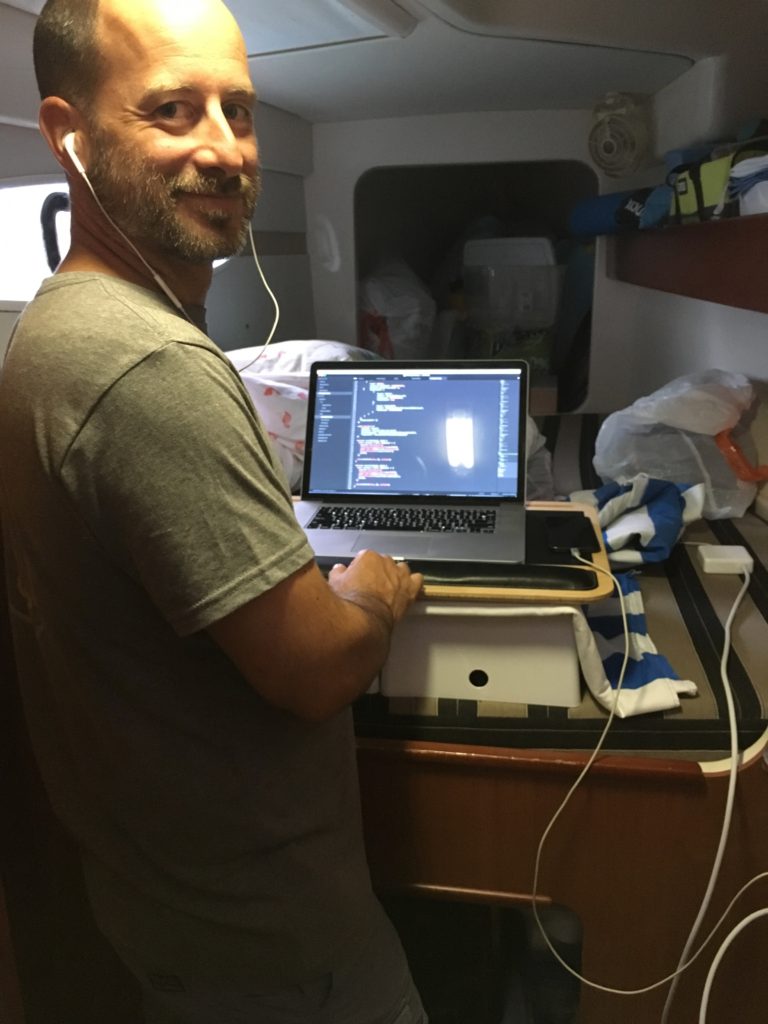We leave magical Rudder Cut Cay and hop up the southern Exumas to Staniel Cay, where we explore the famous Thunderball Grotto. We make a few stops along the way, and have an epic sail.
Magical Mermaids
We leave George Town for the last time this season and start our slow wander north through the Exumas. First stop, Rudder Cut Cay and the magical islands of David Copperfield, where we explore some underwater sculptures, caves, and an epic sand bar.
You Must Be Rich
One of the first things I hear when I tell people that we live on our boat and cruise full time is, “oh, you must be rich!”. Nope – at least not in the financial sense. We were pretty much like every other middle class family in America before we left. My wife and I both worked, had a nice home, paid lots of bills, and were firmly entrenched in the rat race, saving for that magical moment of retirement when we could finally enjoy the fruits of decades of labor. Thankfully, we both woke up and realized that we wanted our lives to be about more than just work and bills. Once the seed of the idea of cruising full-time was planted, there was no stopping its growth into a fully formed plan to sell it all and sail off into the sunset.
In our travels, we’ve met plenty of other cruising families, and financially, they tend to fall into two groups – the “sabbaticals” and the “committed”. The former are people that have saved up enough money to take a year off from work and go cruising. They typically rent our their homes with every intention of selling the boat once their year is done and going back to pick up their land-based life right where they left off. The “committed” are those who have sold it all and have no intention going back in the near term.
In our first year, we mostly fell into the sabbatical group although we knew that we didn’t want to live in the northeast anymore, so we had sold our home. During that first year, we were on a tight budget as we worked our way down the east coast and throughout the Bahamas, but we absolutely fell in love with our new cruising life. It didn’t take long for our thoughts to turn to figuring out how to make this situation more permanent. The first, and really the only question for us was, how could we afford to do that?
The Plan
The obvious answer to this question was that we’ll need to work for some period of time to build up enough savings to take another year off and do a repeat of our first year. We found a reasonably priced marina in Hollywood Florida that we really liked and took a slip there for what we thought would be a year, while I would work full-time as a software engineer for some local company. As luck would have it, I found a contracting gig that allowed me to work remotely and required no travel. It didn’t take me long to realize that I could be sitting in a marina in Florida, or on the hook in the Bahamas and there would be no difference whatsoever in my ability to get my job done and interface remotely with the rest of my team. We had some concerns about things like finding reliable internet, but decided that we would jump over to the Bahamas in the fall of 2017 and give it a try. Once there, we realized pretty much immediately that we had found our answer to the question of how to turn our temporary cruising sabbatical into a sustainable lifestyle – our new normal. Since then, I have been working full-time as a software engineer for a US-based company, having now spent two winter seasons in the Bahamas.
Logistics
When I talk to people about working full-time from our floating home, there are all kinds of questions about basic logistics. How do you get internet? Do you work while underway? How can you work with so many distractions around? It took some trial an error, but I’ve found good answers to all of these questions.
Starting with the very basics, I need two things to work – electricity and internet. The former is plentiful in the Bahamas thanks to almost constant sunshine and the miracle of solar energy. We have a 780 watt solar array mounted on our hard-top, which gives me all the electricity I need to power my various devices. Next on the list in terms of the bare necessities is internet – can’t get much done without that. The best way of getting stable internet by far is through cellular data. WiFi boosters are pretty much useless since the days of free open WiFi networks are long gone. For our first year, I used a BTC sim card in my phone, which I then tethered to my laptop. That worked fine, but we have since discovered Aliv, the new cellular kid on the block in the Bahamas, and found the service to be comparable for a fraction of the price. We can get unlimited data (that is throttled at 200 or 300 Gig depending on who you talk to at Aliv) for $75/mo. That might sound steep to some, but with a stable income it’s a small price to pay for unlimited access to the interwebs. We have our Aliv SIM card plugged into a Netgear mobile hotspot that I bought outright through AT&T in the states so that I could have it unlocked. The only place we lose internet is the area around Warderick Wells in the Exuma Cays Land and Sea Park. Everywhere else we’ve been in the Exumas, we’ve enjoyed constant coverage.
With the basics aside, there’s the question of how we can travel while I’m working. Basically the answer is we travel on the weekends and stay put during the week. This works very well once we’re in the Exumas, where there are hundreds of anchorages all the way down the chain. There are a few longer passages though, that can be problematic because weather windows rarely line up with weekends when we need them to. The trip across the gulf stream is one of these passages. The right weather is critical for safely making the trip, and we don’t want to wait weeks or even months for the right weather to line up with a weekend. In these cases, I take a day or two off as needed. Planning in advance for this time off can be tricky since the weather forecast is only good a few days out, but the team I’m working with is luckily pretty flexible about time off.

Another question that comes up a lot is, “how can you possibly focus on work while cruising?”. True, there are many potential distractions. There’s keeping the boat running, which can be a full-time job by itself, there’s four of us in a very small space typically making lots of noise, there’s an absolute paradise right outside your window, and there are constant activities with other cruising families in places where they congregate like George Town in the Exumas. It did take some getting used to, but I’ve found that all of these distractions are manageable. To start, I have set up my workspace in the fourth cabin of our catamaran, which is otherwise unused. There, I set up a simple standing desk, and I can close the door and feel pretty isolated from the rest of the mayhem on the boat. I also listen to music most of the time while I’m working, which helps to further drown out the noise. As for boat maintenance, I do as much preventative maintenance as I can before we leave the states for the season, and the rest I take care of as needed in the evenings or on weekends. Dealing with the paradise outside the window took some discipline, and I admit that I once faked network issues to get off a call and swim with wild dolphins that happened to show up at our stern, but I have found this to be manageable as well. I just keep reminding myself that work is what makes living in this amazing tropical paradise possible, and at the end of the workday I can close my laptop, jump off the boat and go snorkeling in January.
All in all, I’ve got a pretty good thing going, and working while cruising – complete with it’s compromises and limitations – is way better in my opinion than being tethered to a dock in a marina and working in a soul crushing cube farm.
We Finally Leave George Town
After many months in the same spot, we finally weigh anchor and head to Emerald Bay. Paul leaves for a business trip to the great white north, we pick up Grandma and Pop Pop, and Katie gets kidnapped by pirates!

